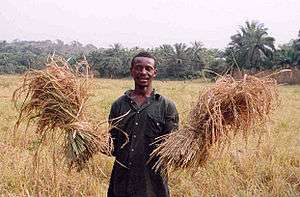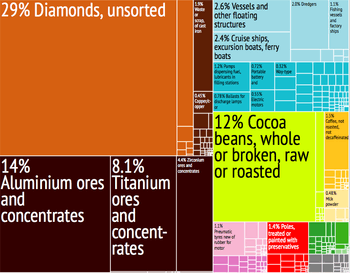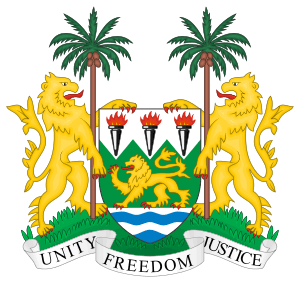Economy of Sierra Leone
The economy of Sierra Leone is that of a least developed country[19] with a gross domestic product (GDP) of approximately US$1.9 billion in 2009.[20] Since the end of the civil war in 2002 the economy is gradually recovering with a GDP growth rate between 4 and 7%.[20] In 2008 its GDP in PPP ranked between 147th (World Bank) and 153rd (CIA) largest in the world.[21]
 A diamond Mine in Kono District. | |
| Currency | Sierra Leonean leone |
|---|---|
| Calendar Year | |
Trade organisations | AU, AfCFTA, African Development Bank, ECOWAS, MRU, World Bank, IMF, WTO, Group of 77 |
| Statistics | |
| GDP | |
GDP growth |
|
GDP per capita | |
GDP by sector |
|
| 16.862% (2018 est.)[1] | |
Population below poverty line | |
| 35.7 medium (2018)[5] | |
Labour force | 2.207 million (2007 est.) |
| Unemployment | N/A |
Main industries | diamonds mining, small-scale manufacturing (cigarettes, beverages, textiles, footwear), petroleum refining, commercial ship repair |
| External | |
| Exports | |
Export goods | diamonds, rutile, cocoa, coffee, fish[10] |
Main export partners | |
| Imports | |
Import goods | machinery, fuel, lubricants, chemicals, food[13] |
Main import partners |
|
FDI stock | |
Gross external debt | |
| Public finances | |
| Revenues | $510.2 million (2012 est.)[18] |
| Expenses | $728.5 million (2012 est.)[18] |
Sierra Leone's economic development has always been hampered by an overdependence on mineral exploitation. Successive governments and the population as a whole have always believed that "diamonds and gold" are sufficient generators of foreign currency earnings and lure for investment.
As a result, large scale agriculture of commodity products, industrial development and sustainable investments have been neglected by governments. The economy could thus be described as one which is "exploitative" - a rentier state - and based upon the extraction of unsustainable resources or non-reusable assets.
Two-thirds of the population of Sierra Leone are directly involved in subsistence agriculture.[22] Agriculture accounted for 58 percent national GDP in 2007.[23]
Economic history
This is a chart of trend of gross domestic product of Sierra Leone at market prices estimated by the International Monetary Fund and EconStats[24] with figures in millions of Sierra Leones.
| Year | Gross Domestic Product |
|---|---|
| 1965 | 246 |
| 1970 | 355 |
| 1975 | 572 |
| 1980 | 1,155 |
| 1985 | 4,365 |
| 1990 | 98,386 |
| 1995 | 657,604 |
| 2000 | 1,330,429 |
Current GDP per capita of Sierra Leone grew 32% in the 1960s, reaching a peak growth of 107% in the 1970s. But this proved unsustainable and it consequently shrank by 52% in the 1980s and a further 10% in the 1990s.
The mean wage was US$0.32 per hour in 2009.
Economic sectors
| Rank | Sector | Percentage of GDP |
|---|---|---|
| 1 | Agriculture | 58.5 |
| 2 | Other Services | 10.4 |
| 3 | Trade and tourism | 9.5 |
| 4 | Wholesale and retail trade | 9.0 |
| 5 | Mining and quarying | 4.5 |
| 6 | Government Services | 4.0 |
| 7 | Manufacturing and handicrafts | 2.0 |
| 8 | Construction | 1.7 |
| 9 | Electricity and water | 0.4 |
Agriculture

Two-thirds of the population of Sierra Leone are directly involved in subsistence agriculture.[22] Agriculture accounted for 58 percent national Gross Domestic Product (GDP) in 2007.[23]
Agriculture is the largest employer with 80 percent of the population working in the sector.[25] Rice is the most important staple crop in Sierra Leone with 85 percent of farmers cultivating rice during the rainy season[26] and an annual consumption of 76 kg per person.[27]
Mining
Rich in minerals, Sierra Leone has relied on the mining sector in general, and diamonds in particular, for its economic base. In the 1970s and early 1980s, economic growth rate slowed because of a decline in the mining sector. Financially disadvantageous exchange rates and government budget deficits led to sizable balance-of-payments deficits and inflation.
Certain policy responses to external factors as well as implementations of aid projects and maintenance have led to a general decline in economic activity and a serious degradation of economic infrastructures. Sierra Leone's short-term prospects depend upon continued adherence to International Monetary Fund programs and continued external assistance.
Telecommunications
Radio is the most-popular and most-trusted media source in Sierra Leone, with 72% of people in the country listening to the radio daily. Sierra Leone is home to one government-owned national radio station and roughly two dozen private radio stations, as well as one government-owned and one private TV station.
Telephone and telegraph services are marginal, but improving. Internet usage is low, reaching just 1.3% of the population in 2012, but improving with growth in 3G mobile cellular data services and the mid-2011 arrival of the ACE international fiber-optic cable system in Freetown.
Tourism
According to the International Labour Organization, approximately 8,000 Sierra Leoneans are employed in the tourism industry, with a growing number of jobs expected to be created in the future. The main entrance point is Freetown International Airport, where transport to and from has been problematic. The main attractions for tourist in Sierra Leone are the beaches, nature reserves and mountains.[28]
Transport
Because of widespread poverty, high petroleum prices and a large portion of the population residing in small communities, walking is often the preferred method of transportation in Sierra Leone. There are 11,700 kilometres (7,270 mi) of highway in Sierra Leone, of which 936 km (582 mi) are paved.
There are 800 km (497 mi) of waterways in Sierra Leone, of which 600 km (373 mi) are navigable year-round. Major ports of Sierra Leone include: Bonthe, Freetown and Pepel. Queen Elizabeth II Quay in Freetown represents the country's only deep water port facility capable of berthing large-hulled cargo or military vessels.
There are ten airports in Sierra Leone, of which one - Lungi International Airport in Freetown - has a paved runway in excess of 3000m in length. Of the remaining airports, all of which have unpaved runways, seven have runways of lengths between 914 and 1,523 m (2,999 and 4,997 ft); the remaining two having runways of shorter length. There are two heliports in the country.
Trade and investment

Mineral exports remain Sierra Leone's principal foreign exchange earner. Sierra Leone is a major producer of gem-quality diamonds. Though rich in this resource, the country has historically struggled to manage its exploitation and export. Annual production estimates range between $70–$250 million; however, only a fraction of that passes through formal export channels (1999: $1.2 million; 2000: $16 million; 2001: projections $25 million). The balance is smuggled out and has been used to finance rebel activities in the region, money laundering, arms purchases, and financing of other illicit activities, leading some to characterize Sierra Leone's diamonds as a "conflict resource."
Recent efforts on the part of the country to improve the management of the export trade have met with some success. In October 2000, a new UN-approved export certification system for exporting diamonds from Sierra Leone was put into place that led to a dramatic increase in legal exports. In 2001, the Government of Sierra Leone created a mining community development fund, which returns a portion of diamond export taxes to diamond mining communities. The fund was created to raise local communities' stake in the legal diamond trade.
Sierra Leone has one of the world's largest deposits of rutile, a titanium ore used as paint pigment and welding rod coatings. Sierra Rutile Limited, fully owned by Nord Resources of the United States, began commercial mining operations near Bonthe in early 1979. Sierra Rutile was then the largest non-petroleum U.S. investment in West Africa. The export of 88,000 tons realized $75 million for the country in 1990.
The company and the Government of Sierra Leone concluded a new agreement on the terms of the company's concession in Sierra Leone in 1990. Rutile and bauxite mining operations were suspended when rebels invaded the mining sites in 1995. Negotiations for reactivation of rutile and bauxite mining are in progress. The U.S. interest in the company has been reduced to 25%.
Since independence, the Government of Sierra Leone has encouraged foreign investment, although the business climate suffers from uncertainty and a shortage of foreign exchange because of civil conflicts. Investors are protected by an agreement that allows for arbitration under the 1965 World Bank Convention. Legislation provides for transfer of interest, dividends, and capital.
Currency and central bank
The currency is the leone. The central bank of the country is the Bank of Sierra Leone which is in the capital, Freetown. The country operates a floating exchange rate system, and foreign currencies can be exchanged at any of the commercial banks, recognized foreign exchange bureaux and most hotels. Credit card use is limited in Sierra Leone, though they may be used at some hotels and restaurants. There are a few internationally linked automated teller machines that accept Visa cards in Freetown operated by ProCredit Bank.
Membership of international economic bodies
Sierra Leone is a member of the Economic Community of West African States (ECOWAS). With Liberia and Guinea, it formed the Mano River Union (MRU) customs union, primarily designed to implement development projects and promote regional economic integration.
The MRU has so far been inactive because of domestic problems and internal and cross-border conflicts in all three countries. The future of the MRU depends on the ability of its members to deal with the fallout from these internal and regional problems.
Sierra Leone is a member of the WTO.
Other statistics[29]
GDP: purchasing power parity - $11.55 billion (2017 est.)
GDP - real growth rate: 3.7% (2017 est.)
GDP - per capita: $1,600 (2017 est.)
Gross national saving: 10% of GDP (2017 est.)
GDP - composition by sector:
agriculture:
60.7% (2017 est.)
industry:
6.5% (2017 est.)
services:
32.9% (2017 est.)
Population below poverty line:: 70.2% (2004 est.)
Distribution of family income - Gini index: 34 (2011)
Inflation rate (consumer prices): 18.2% (2017 est.)
Labor force: 2.972 million (2017 est.)
Labor force - by occupation:
agriculture:
61.1% (2014 est.)
industry:
5.5% (2014 est.)
services:
33.4% (2014 est.)
Unemployment rate: 15% (2017 est.)
Budget:
revenues:
562 million (2017 est.)
expenditures:
846.4 million (2017 est.)
Budget surplus (+) or deficit (-): -7.9% (of GDP) (2017 est.)
Public debt: 63.9% of GDP (2017 est.)
Industries: diamond mining; iron ore, rutile and bauxite mining; small-scale manufacturing (beverages, textiles, footwear)
Industrial production growth rate: 15.5% (2017 est.)
electrification: total population: 5% (2013)
electrification: urban areas: 11% (2013)
electrification: rural areas: 1% (2013)
Electricity - production: 300 million kWh (2016 est.)
Electricity - production by source:
fossil fuel:
23%
hydro:
51%
nuclear:
0%
other renewable:
26% (2017)
Electricity - consumption: 279 million kWh (2016 est.)
Electricity - exports: 0 kWh (2016 est.)
Electricity - imports: 0 kWh (2016 est.)
Agriculture - products: rice, coffee, cocoa, palm kernels, palm oil, peanuts, cashews; poultry, cattle, sheep, pigs; fish
Exports: $808.4 million (2017 est.)
Exports - commodities: iron ore, diamonds, rutile, cocoa, coffee, fish
Exports - partners: Cote dIvoire 37.7%, Belgium 20.5%, US 15.7%, China 10.2%, Netherlands 6.1% (2017)
Imports: $1.107 billion (2017 est.)
Imports - commodities: foodstuffs, machinery and equipment, fuels and lubricants, chemicals
Imports - partners: China 11.5%, US 9.2%, Belgium 8.8%, UAE 7.7%, India 7.4%, Turkey 5.2%, Senegal 5.1%, Netherlands 4.3% (2017)
Debt - external: $1.615 billion (31 December 2017 est.)
Reserves of foreign exchange and gold: $478 million (31 December 2017 est.)
See also
- Extractive industries
- United Nations Economic Commission for Africa
References
- "World Economic Outlook Database, October 2019". IMF.org. International Monetary Fund. Retrieved 22 January 2020.
- "Global Economic Prospects, January 2020 : Slow Growth, Policy Challenges" (PDF). openknowledge.worldbank.org. World Bank. p. 147. Retrieved 22 January 2020.
- "Poverty headcount ratio at national poverty lines (% of population) - Sierra Leone". data.worldbank.org. World Bank. Retrieved 22 March 2020.
- "Poverty headcount ratio at $1.90 a day (2011 PPP) (% of population) - Sierra Leone". data.worldbank.org. World Bank. Retrieved 22 March 2020.
- "GINI index (World Bank estimate) - Sierra Leone". data.worldbank.org. World Bank. Retrieved 22 March 2020.
- "Human Development Index (HDI)". hdr.undp.org. HDRO (Human Development Report Office) United Nations Development Programme. Retrieved 11 December 2019.
- "Inequality-adjusted Human Development Index (IHDI)". hdr.undp.org. HDRO (Human Development Report Office) United Nations Development Programme. Retrieved 11 December 2019.
- "Ease of Doing Business in Sierra Leone". Doingbusiness.org. Retrieved 2017-01-23.
- "2012 Exports figures of Sierra Leone". CIA World Factbook. 2012. Archived from the original on 2012-05-04. Retrieved 2013-07-27.
- "Exports Products of Sierra Leone". CIA World Factbook. Archived from the original on 2015-06-26. Retrieved 2013-07-27.
- "Exports Partners of Sierra Leone". CIA World Factbook. 2012. Retrieved 2013-07-27.
- "2012 Imports figures of Sierra Leone". CIA World Factbook. 2012. Archived from the original on 2018-03-10. Retrieved 2013-07-27.
- "Imports Products of Sierra Leone". CIA World Factbook. Archived from the original on 2018-10-05. Retrieved 2013-07-27.
- "Imports Partners of Sierra Leone". CIA World Factbook. 2012. Retrieved 2013-07-27.
- "Foreign Direct Investment in Sierra Leone". CIA World Factbook. 2012. Retrieved 2013-07-27.
- "2012 External Debt of Sierra Leone". CIA World Factbook. 2012 est. Retrieved 2013-07-27. Check date values in:
|date=(help) - "Public Debt of Sierra Leone". CIA World Factbook. 2012. Archived from the original on 2018-01-20. Retrieved 2013-07-27.
- https://www.cia.gov/library/publications/the-world-factbook/fields/2056.html#sl
- United Nations OHRLLS. Least Developed Countries: Country profiles Archived 2010-03-17 at the Wayback Machine Retrieved 2010-03-24.
- (in German) German Foreign Office. Country Information Sierra Leone - Economy Partly citing the Economist Intelligence Unit. Retrieved 2010-03-24.
- List of countries by GDP (PPP)
- "Settling for a future in Sierra Leone". New Agriculture. November 2007. Retrieved 20 February 2011.
- African Development Bank, OECD - Organisation for Economic Co-operation and Development (2009). African Economic Outlook 2009: Country Notes: Volumes 1 and 2. OECD Publishing. pp. 561–562. ISBN 978-92-64-07618-1.
- http://www.econstats.com/IMF/IFS_Sie1_99B__.htm#Year Archived 2005-02-28 at the Wayback Machine
- König, Dirk (2008). Linking Agriculture to Tourism in Sierra Leone - a Preliminary Research. GRIN Verlag. p. 67. ISBN 978-3-638-94680-3.
- Catling, David (1992). Rice in deep water. Int. Rice Res. Inst. p. 372. ISBN 978-971-22-0005-2.
- Rice today, Volume 3:Rice facts. International Rice Research. 2004. p. 48.
- Europa Publications Limited (31 December 2002). Africa South of the Sahara 2003. Psychology Press. p. 934. ISBN 978-1-85743-131-5. Retrieved 22 March 2011.
- "Africa :: Sierra Leone — The World Factbook - Central Intelligence Agency". www.cia.gov. Retrieved 2018-12-11.
